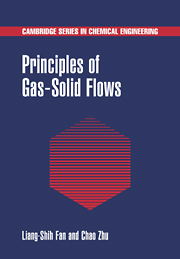Book contents
- Frontmatter
- Contents
- Preface
- Part I Basic Relationships
- 1 Size and Properties of Particles
- 2 Collision Mechanics of Solids
- 3 Momentum Transfer and Charge Transfer
- 4 Basic Heat and Mass Transfer
- 5 Basic Equations
- 6 Intrinsic Phenomena in a Gas–Solid Flow
- Part II System Characteristics
- Appendix: Summary of Scalar, Vector, and Tensor Notation
- Index
4 - Basic Heat and Mass Transfer
from Part I - Basic Relationships
Published online by Cambridge University Press: 27 October 2009
- Frontmatter
- Contents
- Preface
- Part I Basic Relationships
- 1 Size and Properties of Particles
- 2 Collision Mechanics of Solids
- 3 Momentum Transfer and Charge Transfer
- 4 Basic Heat and Mass Transfer
- 5 Basic Equations
- 6 Intrinsic Phenomena in a Gas–Solid Flow
- Part II System Characteristics
- Appendix: Summary of Scalar, Vector, and Tensor Notation
- Index
Summary
Introduction
Gas–solid flows involving heat and mass transfer are common in many engineering operations including petroleum refining, nuclear reactor cooling, solid fuel combustion, rocket nozzle jetting, drying, and bulk material handling and transport. In the chemical process industries, reactors for polymerization and hydrogenation commonly require cooling or heating to maintain desired reaction temperatures. In nuclear reactor cooling or solar energy transportation, graphite suspension flows are used in the heat exchanger. Graphite suspension coolants can have high heat transfer coefficients in addition to other noted properties such as high thermal capacity, good temperature stability, and low pressurization characteristics [Boothroyd, 1971]. Combustion of pulverized coal, gas adsorption on a catalyst, and synthesis of chemicals are among many examples of mass transfer in gas–solid flows.
There are three basic modes of heat transfer, namely, thermal diffusion (heat conduction), convection, and radiation. All three modes may occur simultaneously, or one of them may dominate under certain conditions. The first two modes are analogous to their counterparts in momentum transfer in a fluid. Thermal radiation, a form of energy transfer through electromagnetic waves, is governed by rather different laws and can occur even through a perfect vacuum. It is also noted that an analogy can exist between mass transfer and heat transfer (excluding radiation) because of the similarity of their governing equations.
This chapter describes the fundamental principles of heat and mass transfer in gas–solid flows. For most gas–solid flow situations, the temperature inside the solid particle can be approximated to be uniform.
- Type
- Chapter
- Information
- Principles of Gas-Solid Flows , pp. 130 - 163Publisher: Cambridge University PressPrint publication year: 1998



